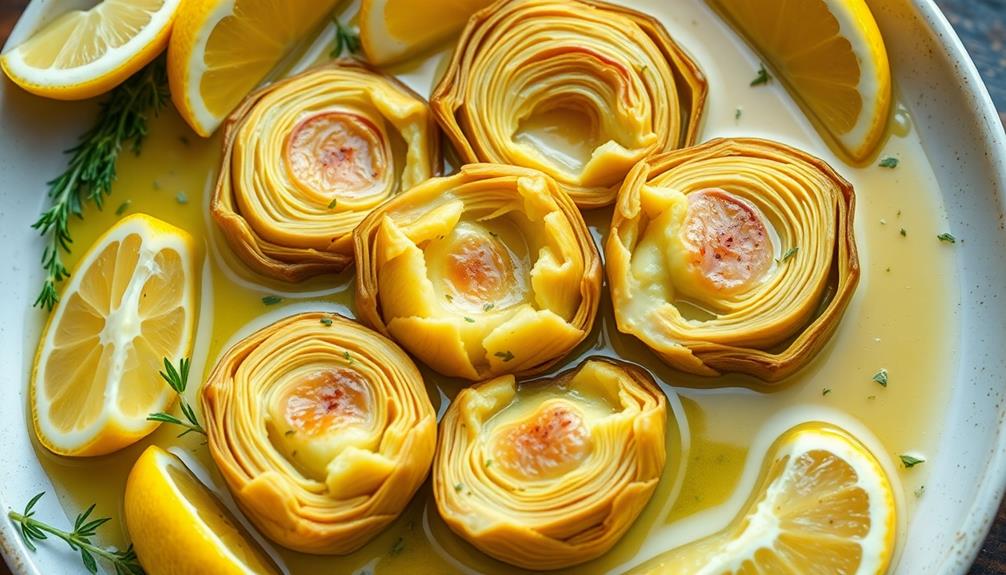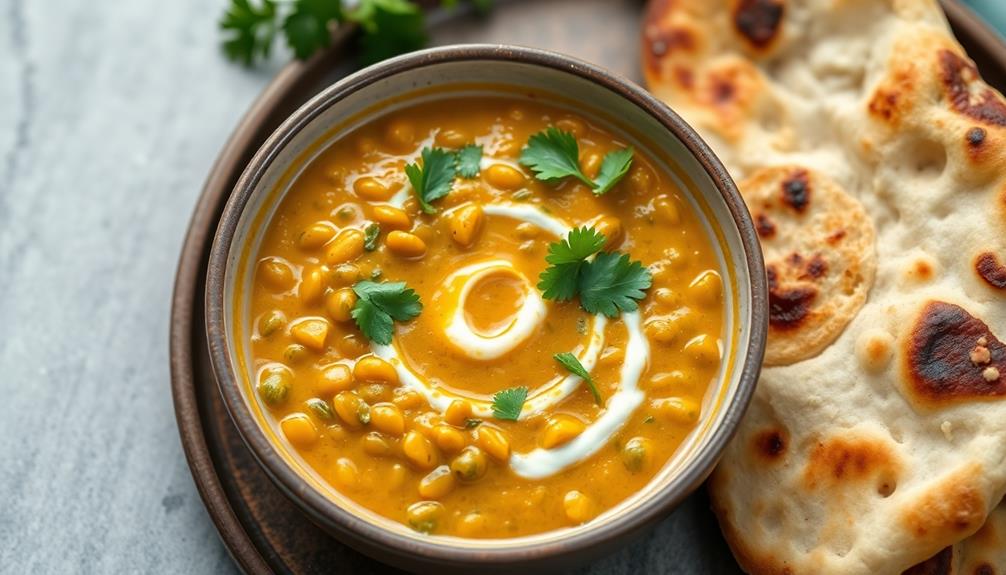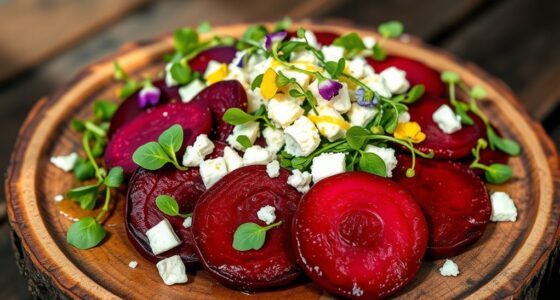Once prized as an exotic delicacy, artichokes are now making a comeback as the star of a decadent butter-braised dish. The slow cooking process transforms tough outer leaves into tender morsels, while the hearts become delightfully creamy. The rich, flavor-infused butter is the secret to this luxurious appetizer, elevating the artichokes' natural sweetness. Serve it warm with a squeeze of lemon, and you've got a delightful crowd-pleaser that'll have your guests wondering why they haven't tried it sooner. Intrigued? Dive deeper into the history and cooking process to discover what makes this appetizer so irresistible.
Key Takeaways
- Butter-braised artichokes are a delectable appetizer featuring tender leaves and creamy hearts, elevated by the rich flavor of high-quality butter.
- The braising technique transforms tough artichokes into a luxurious dish, with the butter significantly enhancing the natural sweetness of the vegetable.
- Artichokes have a long and distinguished history, valued for their medicinal properties and served as delicacies in ancient civilizations.
- This dish can be served as a side or main course, pairing well with crusty bread and complementing various cuisines and dining occasions.
- Butter-braised artichokes are relatively easy to prepare, making them a suitable choice for both casual meals and formal gatherings.
History
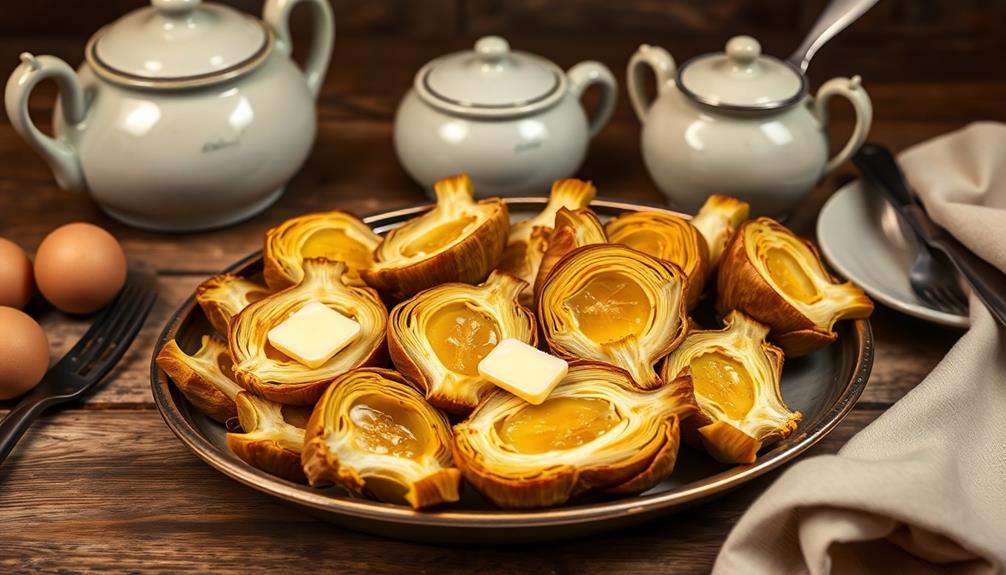
Artichokes have a rich history dating back to ancient civilizations.
These unique, thistle-like vegetables were revered by the Greeks and Romans, who believed they'd medicinal properties and served them as delicacies at their banquets.
In the 16th century, Catherine de' Medici introduced artichokes to the French court, sparking a culinary craze that soon spread across Europe.
Recipe
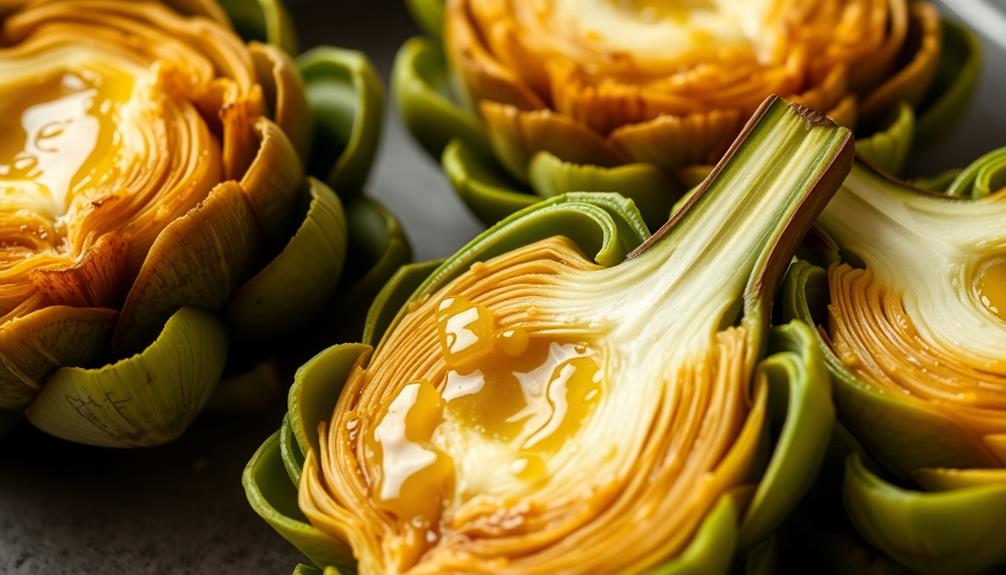
Artichokes, with their intricate leaves and delicate hearts, are a true delicacy. When cooked in a simple yet indulgent butter-braising method, they become a luxurious side dish that can elevate any meal. This technique can be complemented by using high-quality top butter brands for an even richer flavor profile.
The key to perfectly braised artichokes is patience and a gentle touch. By allowing the artichokes to simmer slowly in a bath of fragrant butter, their tough outer leaves transform into tender morsels, while the heart becomes a creamy, buttery delight.
Ingredients:
- 4 medium-sized artichokes
- 1 cup unsalted butter, cubed
- 1 lemon, juiced
- 2 cloves garlic, minced
- 2 sprigs fresh thyme
- Salt and pepper to taste
In a large, heavy-bottomed pot or Dutch oven, melt the butter over medium-low heat. Add the garlic and thyme, and cook for 2-3 minutes, or until fragrant. Carefully add the artichokes, lemon juice, salt, and pepper. Cover the pot and simmer the artichokes for 45-60 minutes, or until the leaves pull away easily and the hearts are tender when pierced with a knife.
When serving these butter-braised artichokes, be sure to provide small dishes for guests to discard the tough outer leaves. The true delight lies in savoring the tender heart and inner leaves, which have absorbed the rich, buttery flavors.
Enjoy this dish as a side or as a main course, paired with crusty bread to soak up every last drop of the fragrant cooking liquid.
Cooking Steps
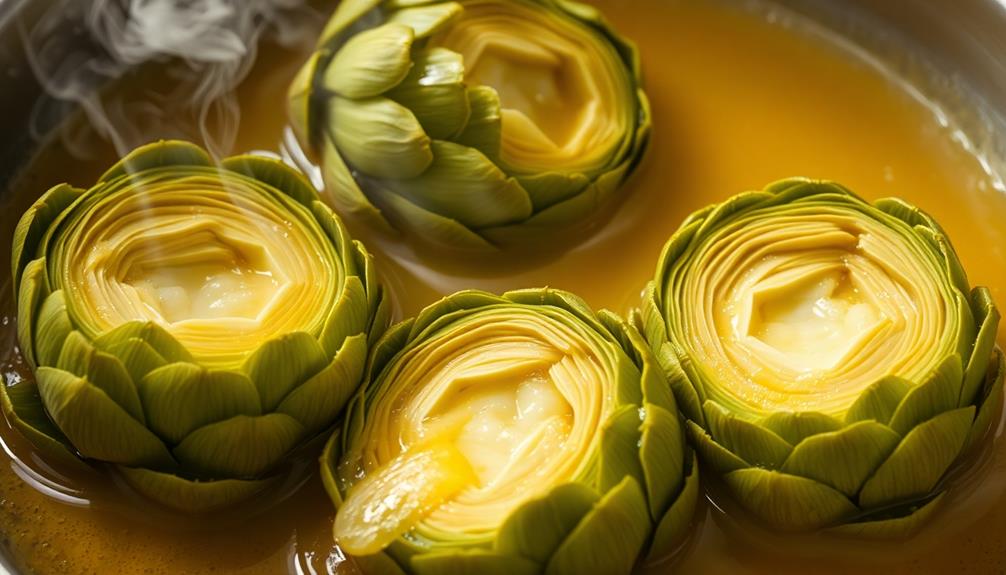
Alright, let's get started! First, you'll need to trim off the tough outer leaves and stems of the artichokes.
Then, melt some butter in a skillet – this is where the magic happens.
Gently add the artichokes to the skillet and let them braise until they're deliciously tender.
Step 1. Trim Artichoke Leaves and Stems
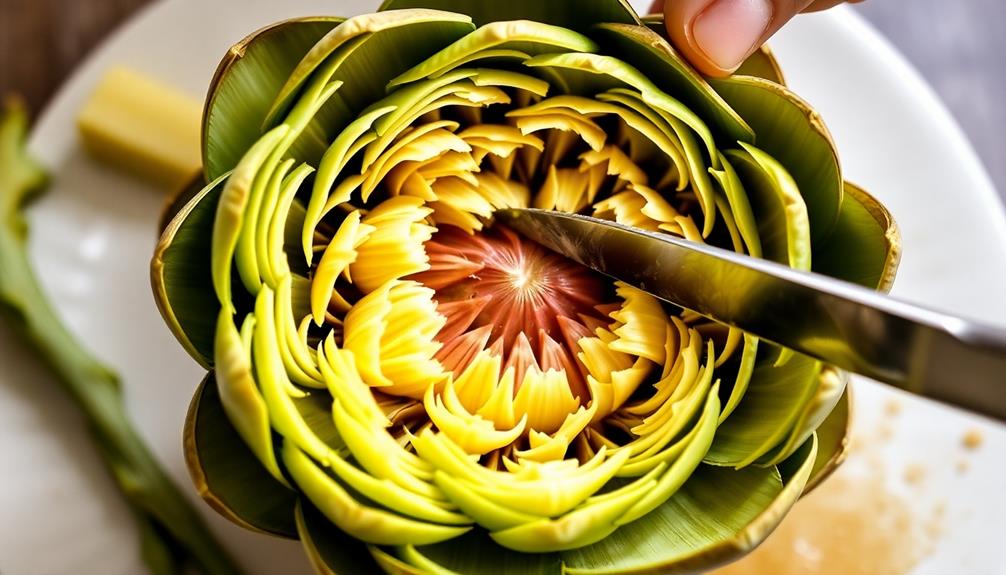
Begin by grasping the artichoke firmly at its base. Grab a sharp knife and slice off the stem, leaving about an inch attached to the base.
Next, peel away the tough, outer leaves until you reach the tender, pale green inner leaves. You may need to use your fingers to gently pull and separate the leaves. Take care not to remove too many, as you want to preserve the artichoke's shape.
With the leaves trimmed, use the knife to trim the top inch or so of the artichoke, slicing off the pointed tips. This will create a flat surface on top.
Run the knife around the base to remove any remaining tough or fibrous parts. Finally, use your fingers to gently spread the leaves outward, revealing the fuzzy choke in the center.
Carefully scoop out the choke with a spoon, being cautious not to remove any of the tender heart. Your artichoke is now ready for the next step in the butter-braising process.
Step 2. Melt Butter in a Skillet
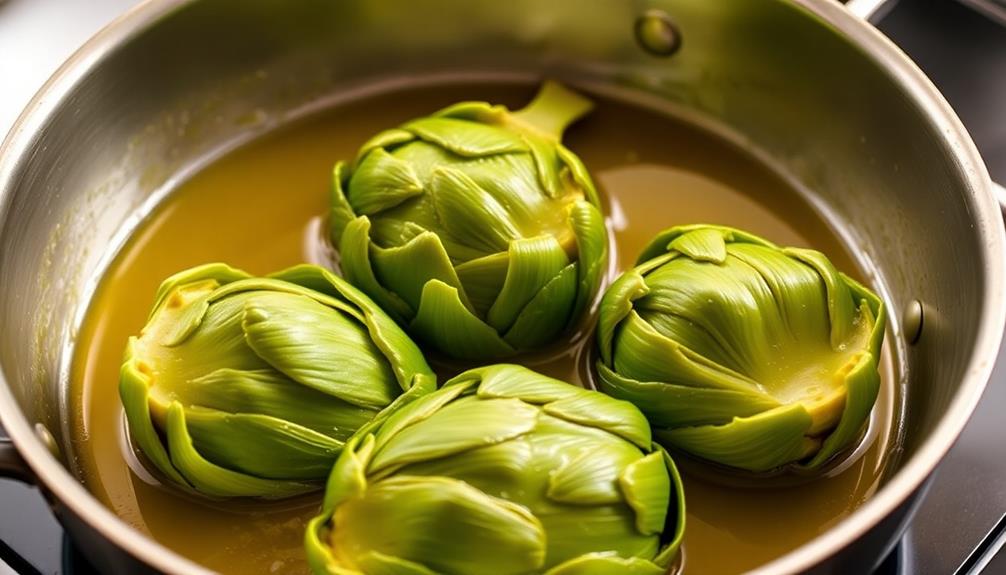
With your artichokes prepped and ready, it's time to start cooking. Grab a large skillet and place it over medium heat. Go ahead and toss in a generous knob of butter – we want enough to coat the bottom of the pan and start sizzling.
Let that butter melt and shimmer, releasing its rich, nutty aroma. As it does, you'll notice the butter starting to foam up. This is exactly what you want! Tilt the pan to ensure the melted butter coats the entire surface.
Now it's time to add your trimmed artichoke hearts. Carefully arrange them cut-side down in the hot butter, making sure they're in an even layer. You'll hear that satisfying sizzle as the artichokes make contact with the pan.
Let them cook, undisturbed, until they develop a lovely golden-brown sear on the bottom, about 5 minutes. This is where the magic starts to happen!
Step 3. Add Artichokes to Skillet

Once the butter has melted and started to foam, it's time to add your trimmed artichoke hearts.
Gently lower them into the hot, fragrant butter, arranging them in a single layer. As the artichokes hit the pan, you'll hear a sizzle that immediately fills the air with their earthy, slightly nutty aroma.
Interestingly, the artichokes can pair beautifully with a cup of brewing the perfect cup of tea for a delightful dining experience.
Tilt the pan to ensure each artichoke heart is evenly coated in the rich, melted butter. Give them a gentle nudge with your spatula, encouraging them to brown and caramelize on the edges.
Watch as the leaves begin to open up, revealing their tender, pale green centers. The artichokes will slowly become infused with the flavor of the butter, taking on a golden hue.
Be patient and let them cook, resisting the urge to move them too much, until they're fork-tender and irresistibly delicious.
Get ready for the first bite – these butter-braised artichokes are about to become your new favorite appetizer.
Step 4. Braise Artichokes Until Tender
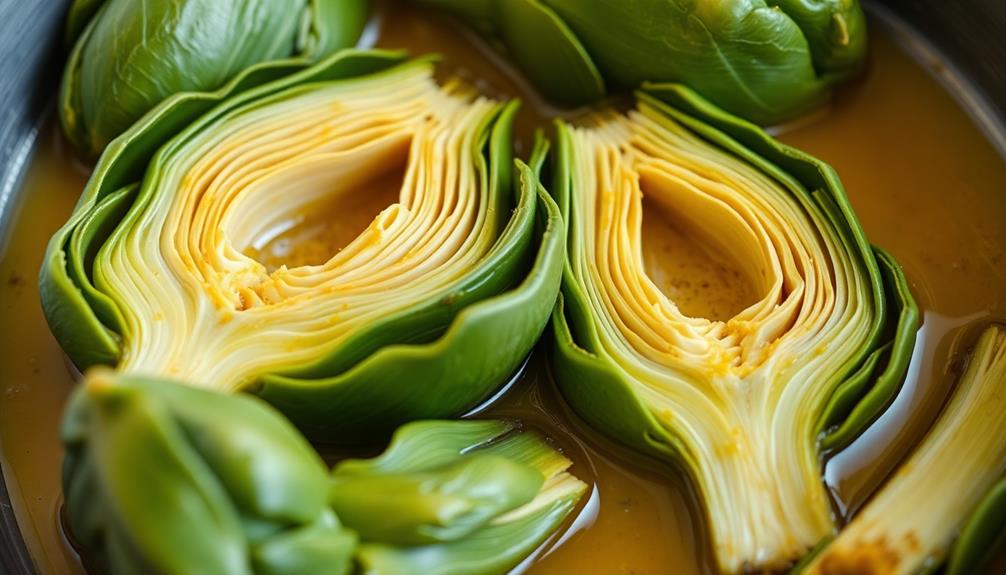
First, cover the skillet and allow the artichokes to braise for about 10-12 minutes. As they cook, the tender leaves will begin to turn a vibrant green, and the hearts will soften, becoming melt-in-your-mouth delicious.
Occasionally, lift the lid to baste the artichokes with the flavorful butter mixture, ensuring every nook and cranny is infused with the rich, aromatic goodness.
After the initial braising time, use tongs to gently flip the artichokes, allowing the other side to become equally tender and caramelized. The leaves should release easily from the base when you give them a gentle tug.
Continue to braise for another 10-12 minutes, or until a knife can be easily inserted into the hearts with no resistance.
The key is to cook the artichokes low and slow, allowing the flavors to meld and the texture to become utterly irresistible.
Once they're fork-tender, you'll know they're ready to enjoy as a wonderfully indulgent appetizer or side dish.
Step 5. Serve Immediately With Lemon Wedges
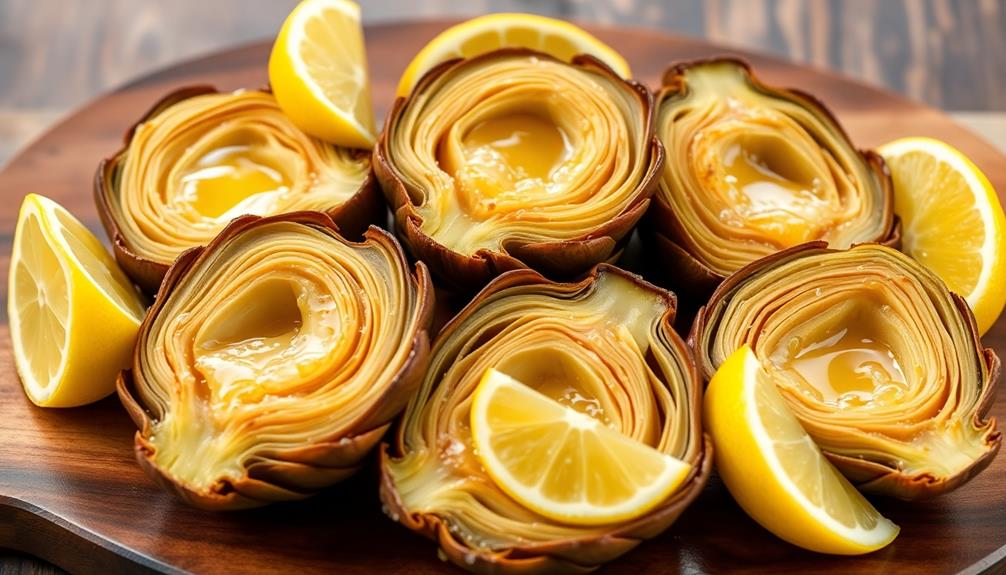
After the artichokes have reached the perfect level of tenderness, transfer them to a serving platter. The golden-brown, butter-kissed leaves are ready to be enjoyed.
Arrange the artichokes in a visually appealing manner, with the hearts prominently displayed. Serve them immediately while they're still hot, as the flavors are simply divine when they're freshly cooked.
Alongside the artichokes, provide a selection of fresh lemon wedges. The bright, tangy acidity of the lemon will perfectly complement the rich, buttery artichokes. Encourage your guests to squeeze the lemon juice over the artichoke leaves, allowing the flavors to mingle and create a mouthwatering experience.
As your guests dive in, they'll be delighted by the tender, flavorful artichoke leaves that practically melt in their mouths. The combination of the rich butter and the bright lemon is a harmonious balance that will leave them craving more.
Savor every bite and enjoy the simple pleasure of these butter-braised artichokes.
Final Thoughts

Ultimately, butter-braised artichokes make for a delightful side dish that'll delight your taste buds. The tender, flavorful artichoke hearts bathed in a rich, creamy butter sauce are simply irresistible.
Serve them immediately with a squeeze of bright, tangy lemon, and you've got a mouthwatering appetizer or side that'll have your guests raving. The lemon's acidity perfectly balances the butter's richness, elevating the artichokes' natural sweetness.
Plus, they're easy to prepare, making them a fantastic option when you want to impress with minimal effort. Whether you're hosting a dinner party or simply treating yourself to a special weeknight meal, these butter-braised artichokes are sure to become a new favorite.
Frequently Asked Questions
Can I Substitute Other Vegetables for Artichokes?
Absolutely! You can substitute other vegetables for artichokes in this recipe. Try using baby potatoes, carrots, or even mushrooms – they'll all absorb the rich, buttery flavor beautifully. Get creative with your veggie choices!
How Long Do the Artichokes Stay Fresh After Cooking?
The cooked artichokes will stay fresh for 3-4 days when stored in an airtight container in the refrigerator. They'll retain their tender texture and delicious flavor, so you can enjoy them as a tasty appetizer throughout the week.
Can I Make This Recipe in Advance for a Party?
Absolutely! You can make this recipe in advance for a party. The artichokes will hold up well and retain their flavor. Just reheat them gently before serving to ensure they're hot and delicious.
Is There a Vegetarian or Vegan Version of This Dish?
Yes, you can create a delicious vegetarian or vegan version of this dish. Simply substitute the butter with a plant-based alternative like olive oil or coconut oil, and you'll have a flavorful, plant-based artichoke appetizer.
Can I Use Frozen Artichokes Instead of Fresh?
You can definitely use frozen artichokes instead of fresh. They'll cook up just as tender and flavorful. Just be sure to adjust the cooking time accordingly, as frozen artichokes may require a bit less time to become tender.
